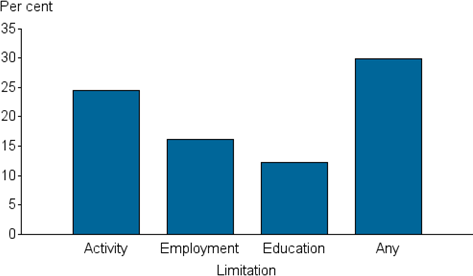Disability status
For the first time in the 2015 collection, the National Prisoner Health Data Collection (NPHDC) included information on disabilities among prison entrants, including both physical and intellectual disabilities. These data were collected in the NPHDC using the AIHW's 'Standardised Disability Flag', which is a set of questions to identify people with disabilities or long-term health conditions who experience difficulties and/or need assistance in various areas of their life.
Long-term health conditions are those which have lasted, or are expected to last, for at least 6 months. Examples of long-term health conditions that might restrict a person's everyday activities include severe asthma, epilepsy, mental health conditions, hearing loss, arthritis, depression, autism, kidney disease, chronic pain, speech impairment or stroke. For this flag, a long-term health condition or disability does not have to be medically diagnosed, but rather is self-reported from the perspective of the respondent.
The items from the Flag collect information on restrictions to participation in education or employment, and limitations to daily activities such as self-care, mobility, communication, learning and applying knowledge, managing things around the home, managing tasks and stressful situations, personal relationships and community life.
Three in ten prison entrants (30%) reported long-term health conditions or disabilities limiting daily activities (reported by 24% of entrants), or restricting participation in education (12%) or employment (16%), with some affected in more than one of those areas (Figure 1):
- Women were more likely than men to have activity limitations (34% and 23% respectively).
- Both activity limitations and restrictions in employment were more common among non-Indigenous (26% and 18% respectively) than Indigenous (21% and 12%) entrants.
- Restrictions and limitations increased with age, and 45% of the oldest entrants (aged at least 45 years) reported having some form of limitation or restriction.
- 15% of entrants reported having difficulty, and a further 6% said they always or sometimes need help or supervision with at least one activity.
Figure 1: Prison entrants, activity limitation or restriction in employment and education, 2015

Sources: Entrant form, NPHDC 2015.
Comparison with the general community
Over two-thirds (69%) of prison entrants aged 35–54 had an activity limitation or participation restriction compared with just over half (52%) of their general community counterparts:
- Among Indigenous 35–54 year olds, those in the general community were more likely than prison entrants to have a limitation or restriction (38% and 29% respectively).
- For non-Indigenous 35–54 year olds, the opposite was true, with 14% of the general population having a limitation or restriction, compared with 40% of prison entrants.
Further information
See Chapter 10 of The health of Australia's prisoners 2015.



